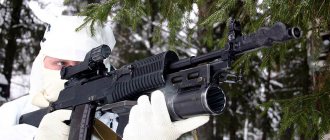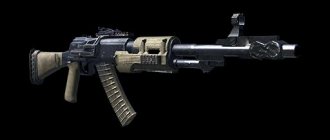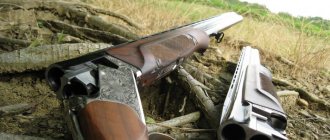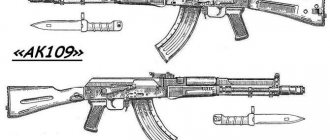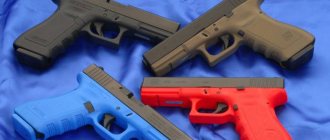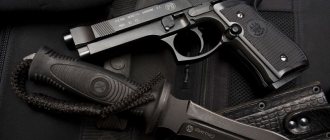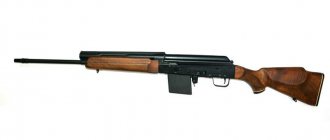Description
Viper-5 is the only representative of the class of submachine guns in the series. He uses a pistol-caliber cartridge for equipment, which defines his niche: this cartridge has a fairly strong stopping power (lethality), but has poor armor-piercing properties and has poor persistence (the bullet drops quite quickly with distance). The submachine gun itself has a fairly high rate of fire and “convenience” (a parameter that affects the character’s turning speed while holding a weapon), and also has one of the fastest reloads, but the accuracy leaves much to be desired.
The main feature is the pistol cartridge. Although the damage is slightly higher than that of assault rifles, the penetration ability of the cartridge is very low. Please note that it is better to shoot with improved JHP ammunition, so although the penetration power will remain small, the damage will increase by 50%, and it also has one very useful feature - better damage against mutants.
“Viper-5” is saved by the possibility of pumping. It allows you to either somehow improve the effective range (that is, upgrade the weapon along the sniper branch, increasing flatness and accuracy), or “forget” everything and improve the capabilities of the submachine gun at close range. The first does not seem very reasonable: the Viper-5 will still be outperformed by all assault rifles, having only slightly higher nominal damage (not taking into account penetration). The second will allow you to use the Viper-5 until the end of the game as a very good means of fighting against mutants, on a par with shotguns, which, however, use a pistol cartridge that is lighter in both weight and location, if you change the caliber from 9x19 to 9x18.
Story
In the mid-sixties of the last century, many weapons experts came to the conclusion that pistols no longer met the requirements of special forces soldiers. But machine guns are not suitable for them due to their heavy weight, low stopping power and increased penetration ability. Yes, the last factor is a disadvantage when it comes to weapons used in large cities, if there are civilians nearby.
That is why in 1964, experts from the Heckler and Koch plant (by the way, the real heir of the legendary Mauser) began work on creating a completely new weapon. And in the same year, a prototype was exhibited, called NK54. The number 5 indicated that the weapon was a submachine gun. And 4 showed that it uses the very popular 9x19 parabellum cartridge. the letters NK indicate the manufacturer - Heckler & Koch.
After two years of testing and bringing the weapon to ideal characteristics, it was accepted for service. First of all, it was armed with GSG9, one of the German special forces units that has proven highly effective in carrying out the most difficult tasks. Then it received the usual name MP5 - Maschinenpistole. So the HK MP5 assault rifle began its march across the planet.
Location
- Swamps - on the table in the pumping station, but can be randomly picked up by renegades.
- Swamps - caches “Backpack in the swamps” and “Backpack on the island”.
- Swamps are the weapon of some renegades and Clear Sky fighters.
- Cordon - cache “Reward for the hero”, Shilov sells the tip for 2000 RU.
- Cordon - rarely found in single individuals.
- Landfill - used everywhere.
- Dump - in the Smuggler's hiding place.
- Landfill - hiding place "Shield under the canopy."
- Dark Valley - “Box on the Tower” and “Backpack in the Cabin” caches; a tip to the first is sold by Ganja and Ashot for 2800 RU.
- The Dark Valley is for Svoboda members of the “Novichok” rank.
- Research Institute "Agroprom" - occasionally found among loners and bandits.
- Amber - used by some zombies.
Main advantages
Now let’s figure out why the weapon is so popular - it’s no coincidence that the MP5 airsoft machine is one of the most popular, not to mention a real weapon.
First of all, it is worth noting the high muzzle energy - about 650 joules. This ensures the excellent striking and stopping effect of the bullet.
If necessary, the weapon can be modified. Silencers, optical and collimator sights, and a tactical flashlight are installed on it, which significantly increases the level of comfort during operation.
The design is quite simple, which further increases reliability.
Finally, the submachine gun boasts excellent ergonomics and thoughtful design. The weight of 3 kilograms is not too much, but here it is also distributed correctly. In addition, the angle and shape of the handle provide the most comfortable grip. And you can remove the weapon from the safety or switch the fire mode without even loosening your grip on the handle.
Interesting Facts
- Viper-5 is the only submachine gun in the series. Early versions also included P90, H&K G53 and PP-19, but then they were cancelled.
- This is the only weapon in the game with a roller bolt.
- In reality, this weapon has serious shortcomings. But there are also a lot of advantages, for example: relative reliability, successful design, ease of use and compactness, high lethal and penetrating force.
- In most games and films, the MP5 looks different than in the STALKER series of games: with a folded stock, a tactical grip on the front instead of a stock, and a completely different color scheme. The game uses an early MP5A3, while other games and movies use later versions.
- The game uses an old MP5 model with an old style direct magazine.
- When firing, the sight deviates from the target to the left, just like other H&K MP series submachine guns.
- The front sight, ring sight and other sighting devices have been slightly changed in comparison with the original.
- The Viper-5 model, in particular the sight, front sight and general outline are similar to the SGI-5k.
Specifications
As mentioned above, the weapon used the 9x19 cartridge - proven over several decades of active use, including World War II. This provided fairly high power with excellent stopping power. At the same time, the penetration properties were not too high - exactly what both police officers and special forces soldiers needed.
However, a relatively small supply of gunpowder reduced the power of the shot. Yes, this reduced the combat range. But it increased the accuracy and ease of firing. And a high range when shooting indoors is not at all an important advantage.
When reviewing the MP5 assault rifle, many experts note its light weight - 3.03 kilograms. And, more importantly, the weapon turned out to be compact, with a very well located center of gravity. Thanks to this, experienced fighters can fire with maximum comfort, which ensures excellent performance.
Modifications, even with a fixed butt, have a very short length - only 680 millimeters. If we consider a weapon with a telescopic butt, then this figure is reduced to 550 millimeters.
The small charge of gunpowder led to the fact that the bullet speed was not high - only 400 meters per second. But when working in the city or buildings, this, as already mentioned, cannot be called a disadvantage.
But the rate of fire is very impressive - 800 rounds per minute.
Stores with a capacity of 10 to 30 rounds can be used for food.
Main disadvantages
But every weapon has its drawbacks. And the MP5 machine gun, a photo of which is attached to the article, is no exception.
One of the disadvantages is the high cost. Needless to say, high-quality materials and high-precision fit are not cheap. Perhaps this is why the Bundeswehr has not yet abandoned the Israeli Uzi and switched to its own weapons.
Another disadvantage is the capriciousness of the living conditions. Even a small amount of dirt or dust falling on the moving parts of the weapon can temporarily disable it. Therefore, it is clearly not suitable for mass armament of the army.
Replacing a magazine takes quite a long time. Even an experienced fighter will need a few seconds to do this - in a fast-paced urban battle, this time can cost the user his life.
Where is it used?
Today, the MP5 submachine gun is actively used all over the world. Only officially it was purchased for more than three dozen countries. Among them are Russia, Kazakhstan, Switzerland, USA, Thailand, Japan, China, Norway, Vatican, Georgia, India and a number of others.
In some cases, the weapon is in service with the army. But most often it is used only by special forces. For example, in the Vatican this is the legendary Swiss guard. In Kazakhstan, the guards at the Baikonur Cosmodrome are armed with it. In Russia it is used by the Alpha and Vympel detachments, as well as special detachments of the Airborne Forces and the Ministry of Internal Affairs.
Existing modifications
Today there are seventeen modifications of this legendary weapon. Some are outdated and discontinued, while others are actively produced and used all over the world. The latter include six models. Let's talk about each of them in more detail.
- MP5 A2 is a classic model, significantly lightweight thanks to the empty plastic stock. The weight of the weapon is only 2.54 kilograms.
- MP5 A3 – differs from the previous model only in the butt. It was made telescopic, which made it possible to make the weapon much more compact - the length is 550 mm.
- MP5 K is a product of the desire to reduce the size of the weapon as much as possible. Developed in 1976. It received a shortened forend and barrel, due to which the length was further reduced - only 325 millimeters and weighing 2 kilograms.
- MP5KA1 is the most compact weapon in the line. Compared to the previous modification, the width has been reduced to 50 mm.
- MP5 SD1 is a very successful weapon, developed in 1974. The submachine gun received a perforated barrel and a built-in silencer.
- MP-5N is the most modern version. The folding stock reduced the dimensions, and the body, almost entirely made of plastic, reduced the weight. Has a thread on the barrel for installing PBS. It is from this weapon that the Galaxy G 5 MP5 PDW airsoft machine gun is copied.
As you can see, the list is quite large, and this is an indicator of success.
Heckler&Koch MP.5 submachine gun
In 1964, specialists from the West German company Heckler & Koch Gmbh in Oberndorf am Neckar developed, based on the G.3 automatic rifle, a new 9-mm NK.54 submachine gun, designed to use 9x19 mm NATO (PARABELLUM) pistol cartridges.
It consisted of the main parts and mechanisms: a barrel with a bolt box; shutter; trigger mechanism with box and pistol grip; butt plate of the bolt box with a return mechanism and butt; reloading mechanism; forend; sights and a box magazine. West German Heckler & Koch MP.5 submachine guns in service with the Croatian police
The automatics of the Heckler & Koch NK.54 submachine gun worked on the recoil principle of a semi-free bolt with a roller accelerator. In addition to the fact that this design was distinguished by its simplicity, the low weight of the shutter and the fairly heavy frame made it possible to reduce the speed of movement of automation parts and reduce shock loads when opening and closing the shutter. The semi-free shutter made it possible to significantly reduce the weight of the NK.54.
This submachine gun had several features: 1. Firing was carried out from the front sear, which, in combination with the original design of the bolt, made it possible to significantly reduce the dispersion of bullets during single firing, because Due to the absence of a heavy bolt moving before firing, the weapon was subject to less vibration when fired. 2. The location of all the moving parts of the automatic system above the barrel made the weapon more stable during automatic shooting. 3. An original anti-rebound device was introduced in the form of two longitudinal chambers located in the bolt stem and partially filled with heavy balls. When the shutter stopped in its extreme position, the balls continued to move forward by inertia, acting on the front walls of the shutter chambers, which absorbed the rebound energy of the shutter stem, preventing it from moving backward.
9-mm submachine gun MP.5 A2
The bolt box of the new submachine gun was a stamped-welded part of a complex design. On both sides of the bolt box there were extrusions that served as guides for the bolt stem, as well as extrusions to increase rigidity. The aggregate-type trigger mechanism is assembled in a special trigger box, which was very convenient during the operation and maintenance of the weapon. The hammer mechanism has a separate striker and mainspring. The rotating trigger completely eliminated the possibility of an accidental shot, providing better combat accuracy than in conventional submachine guns that fire from the rear sear. The trigger mechanism allowed for single and automatic fire. On the muzzle of the barrel there was a slot-like muzzle brake - a compensator. Open sighting devices consisted of a rack-mount front sight and a reversible rack-mount diopter sight, designed for a firing range of up to 100 m. The translator, also known as a flag-type fuse, was located on the left side of the trigger mechanism box above the pistol grip. The left-hand reloading mechanism was located in a tube with a safety cutout located above the barrel. NK.54 had an automatically folding spring-loaded reloading handle with a rod that acted on the moving parts when the handle was pulled back. The connection between the reloading mechanism and the moving parts of the automation is one-way: the bolt with the bolt stem could only be pulled back. If the bolt stem did not reach the forward position, it was almost impossible to send it forward using the reloading mechanism, which was a serious design flaw of this weapon. At the same time, the advantages of such a reloading mechanism include the automatic folding of the reloading handle into the non-working position, making the weapon more convenient to use. On the rear wall of the magazine neck there is a transversely moving magazine latch with its control lever. In case of failure, the latch can be turned off by pressing its head on the right side of the bolt box. Cartridges were fed from detachable box magazines with a capacity of 10, 15 or 30 rounds. The submachine gun was equipped with a hard butt.
9-mm submachine gun MP.5 A3
In 1966, law enforcement agencies of West Germany (police and border guards) adopted two models of 9-mm submachine guns designed by Heckler & Koch: MP.5A2 and MP.5A3, created with taking into account the latest advances in weapons technology. The MP.5A2 received a hard plastic stock, and the MP.5A3 was equipped with a retractable metal stock, which reduced the overall length of the weapon. The MP.5A2 was also equipped with a new, more successful sight, made in the form of a rotating drum with four diopter holes, designed for firing ranges of 25, 50, 75 and 100 m. Instead of a muzzle brake-compensator, three protrusions appeared on the muzzle of the barrel for attaching special devices (bushings for firing blank cartridges or devices for silent-flameless shooting).
Heckler & Koch MP.5 submachine guns could be equipped with a wide variety of sights. The sights were mounted on the left side of the bolt box on stampings. In 1977, straight box magazines were replaced by more convenient sector ones, which significantly improved the supply of cartridges with various types of bullets. At the end of the 80s, a new version of the MP.5A4 appeared, in which the trigger mechanism, in addition to single and automatic fire, allows firing in fixed bursts of three shots.
9-mm MP.5 SD submachine gun
Based on the standard MP.5, numerous modifications were created in the 70-80s, including weapons equipped with sound silencers - a series of MP.5SD submachine guns. The main feature of the new model is a lower initial bullet speed - approximately 285 m/s (in MP.5 - 400 m/s). Together with the built-in device for silent and flameless shooting, this made it possible to reduce the sound level of a shot to 80-100 decibels. The expansion type silencer did not disrupt the functioning of the weapon, including when firing in bursts, and also did not affect the accuracy of shooting, since it does not contain elements that can be shot through. The MP.5SD can be equipped with any optical and night sights equipped with special mounts.
In 1976, small-sized MP.5K submachine guns appeared, created to arm special units of the West German Federal Border Service. They were greatly shortened samples of the standard MP.5 and could be freely placed under clothing or in any limited volume, for example, in a “diplomat” type suitcase. Despite all the diversity, the MP.5K models have one common feature - the absence of a stock. Instead, a belt loop is attached to the butt plate on a rotating swivel, which serves as a tension stop to stabilize the weapon when firing. And in place of the fore-end, a front pistol grip is mounted, which serves as another additional support, which allows, despite the extremely small dimensions of this weapon, to firmly hold it when firing and conduct fairly targeted fire from it.
9-mm MP.5 SD submachine gun with telescopic sight
At the request of the American FBI, Heckler & Koch launched production of another model of submachine guns, the MP.5/10, in the early 90s. They are chambered for standard FBI 10mm Auto cartridges. The use of more powerful cartridges required changes not only to the design of the barrel and chamber, but also to completely redesign the magazine. A detachable straight-shaped box magazine with a capacity of 30 10-mm cartridges was made of impact-resistant plastic. A special metal bracket made it possible to connect two magazines in pairs. Soon the MP.5/40 variant appeared, designed to use another American pistol cartridge, the 40 Smith & Wesson. Both models of submachine guns intended for the American arms market received an improved firing mechanism designed to fire single, fixed (three shots) and fully automatic fire in bursts.
A subsidiary of Heckler & Koch Inc. in the American city of Sterling in the early 90s, it mastered the production of modernized MP.5K-PDW submachine guns, designed to use 9-mm Parabellum pistol cartridges. This weapon was created as part of a program actively implemented in the United States - Personal Defense Weapon (personal self-defense weapon). One of the requirements for the weapon was the ability to control it when firing with one hand. Therefore, such samples received another name - “weapons of free hands.” The MP.5K-PDW was distinguished by a more convenient to use metal frame stock that folded to the right and the ability to install a removable silent-flameless firing device. The trigger mechanism provided the ability to fire, along with single and automatic fire, in fixed bursts of 2-3 shots. Especially at the request of the FBI, the same company began producing two more models based on the MP.5A2 and MP.5A3 under the general name “9-mm MP.5SF submachine gun,” which are intended for firing only with single fire.
Over the 37 years of production, Heckler & Koch submachine guns have become widespread. One of the first MP.5s was adopted by the special West German anti-terrorist unit of the Federal Border Guard - the GSG 9 group.
9-mm submachine gun MP.5 SD1
What added to the popularity of the MP.5 was the fact that it was this weapon, or rather one of its modifications – the MP.5SD4 (equipped with a silencer) that was armed with commandos of the CRW group from the 22nd separate SAS regiment in during Operation Nimrod on May 5, 1980, the storming of the Iranian embassy in London, captured by extremists from the Revolutionary Democratic Front for the Liberation of Arabistan, opposition to the regime of Ayatollah Khomeini.
The threat of Iranian terrorists killing 20 hostages forced the British government to act without delay. The operation was complicated by the fact that the hostages were held in several small rooms on the three lower floors of the five-story building. A small-sized weapon with a relatively low rate of fire and high shooting accuracy was required. The British recognized that German submachine guns fully meet these criteria. Simulating a frontal attack on the embassy, five teams of SAS commandos abseiled from the roof and entered the building from the rear. Having previously bombarded the premises with grenades containing CS tear gas, the commandos neutralized seven terrorists and freed the hostages in just 11 minutes with precise shots from MP.5 and Browning HP M.35 pistols. 9-mm MP.5 K submachine gun
Today, various modifications of Heckler & Koch submachine guns are used by many police and anti-terrorist special forces. In the USA - the 1st operational unit of the special forces Delta Force and the SWAT units of the federal police and the FBI, in the UK - the group for special tasks CRW, created as one of the structural units of the special airborne service SAS, in Germany - the GSG 9 group and the criminal KSK police, in Italy - NOCS and the underwater operations team COMSUBIN, in France - the rapid reaction group of the national gendarmerie GIGN and the naval riflemen-commando unit GROUFUMACO, in Belarus - the special group of the Ministry of Internal Affairs "Almaz" ... This weapon is also popular among special forces of the armed forces of many countries around the world . In particular, in the American reconnaissance units of the Marine Corps and special operations groups of the Navy SEAL (“seals”), in the French Marine Commando units.
Thanks to advanced manufacturing technology and meticulous production organization, Heckler & Koch made its submachine guns one of the leaders in individual automatic weapons of the second half of the twentieth century. MP.5 in a wide variety of modifications are in service with the armies, law enforcement agencies and intelligence services of more than fifty countries.
Sergey Monetchikov Photo from the author’s archive

